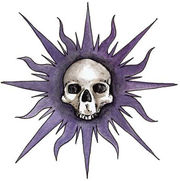Cyric
Cyric (pronounced SEER-ick), whose titles included The Lord of Three Crowns, The Mad God, and The Prince of Lies, was the monomaniacal deity of strife and lies with an immense following, though after he murdered Mystra and caused the Spellplague, his faith diminished somewhat. He was petty and self-centered, and enjoyed misleading individuals of all inclinations so that they performed acts that ruined their lives or so that they made fatal mistakes. Cyric was closely associated with the essence of murder, conflict, lies, intrigue, and illusions. Cyric was recognized in Faerûn by his symbol, a white jawless skull on a black or purple sunburst, and his alignment was chaotic evil. He was a greater power, who ruled supreme in his divine realm, the Supreme Throne. Gugari worshipers knew Cyric as Sirhivatizangpo and he was called N’esr by the Bedine.
Relationships
Cyric hated most of the other deities of Toril, but he particularly loathed Mystra, Kelemvor, and Bane. Cyric had no divine allies, but he made himself a wide variety of enemies. These included gods such as Mystra, Kelemvor, Oghma, Azuth, Mask, Tyr, Torm, Deneir, Leira, Iyachtu Xvim (deceased 1372 DR), Bane, and many others.
History
Before the Gods War, Cyric was a mortal thief hailing from the streets of Zhentil Keep. He attempted to steal the Ring of Winter from a powerful tribe of frost giants, but was unsuccessful and became trapped in their cave. The opportunity to flee only came when a band of adventurers, including the mercenary Kelemvor Lyonsbane, attacked the frost giants’ lair while also trying to find the Ring of Winter. Kelemvor’s entire party, save himself, was slain and only he and Cyric managed to escape. Once back in Arabel the two eventually joined Adon, a young cleric of Sune, and they took work for the local city watch to uncover a traitor.
As the Time of Troubles began in 1358 DR, they met Caitlin, who beseeched the trio to help her on a quest to free the now-mortal Lady of Mysteries, who had been imprisoned in Castle Kilgrave north of Arabel by Bane. Along the way, they met Midnight, a beautiful wizardess. Once the goddess had been freed, she attempted to ascend the Celestial Stairway to confront Helm, the God of Guardians, with the information that Bane and Myrkul had stolen the Tablets of Fate. But Helm’s orders were clear, and without the two Tablets he would not let Mystra pass, and thus the Lady of Mysteries attacked the God of Guardians in a bid to pass him and re-enter the planes. Helm, having retained his divine powers for just the purpose of guarding the stairways, easily slew Mystra. On Midsummer, her divine essence was spread over the nearby lands by a powerful explosion as her avatar was destroyed. Helm’s mention of the tablets, as well as witnessing the destruction of a deity, did much to kindle the powerlust in the young Cyric, and when Midnight announced that the now-dead goddess of magic had instructed her to recover the tablets, Cyric was eager to help, planning to take the tablets for himself when chance came.
Cyric the God
On Marpenoth 15, 1358 DR, Cyric ascended to godhood. At some point after this, Cyric killed Leira, making himself the God of Deception, Murder, Strife, the Dead (a title he later lost to Kelemvor), and Intrigue (when he temporarily killed Mask). Cyric also released Kezef the Chaos Hound, and created a book called the Cyrinishad, a magical tome that proclaimed him the One True Deity. This last plot ultimately failed (though not before the book was written and read by both Mask and Cyric, which cost Mask most of his power and drove Cyric insane).
In 1385 DR, in retaliation for his murder of Mystra, which sparked the Spellplague, Lathander, Tyr, and Sune trapped Cyric in the Supreme Throne for 1000 years.
Worshipers
The Church of Cyric was hated all over Toril, and for good reason: Cyric’s church was pledged to spread strife and work murder everywhere in order to make folk believe in and fear the Dark Sun. It supported cruel rulers and indulged in intrigue in such a way that the world wouldn’t be overrun by wars (thus falling under the sway of Thor). His church was often beset by internal feuds and backstabbing, but this conflict decreased in recent years as Cyric gained better control of himself and consolidated the churches of the deities whose portfolios he took over.
Cyric’s clerics, who often trained as rogues or assassins, prayed for spells at night, after moonrise. Cyric’s church had few holy days and did not even celebrate the date of his ascension to divinity (this would also honor Mystra, called “the Harlot” by Cyricists). Whenever a temple acquired something, or someone, important enough to be sacrificed, its high priest declared a Day of the Dark Sun to signify the holiness of the event. Eclipses were considered holy, being accompanied by feasts, fervent prayers, and bloody sacrifices.
The religion of Cyric was widely and openly active in Amn. It fit in well with their culture of ambition, lack of reliance on others, and “buyer beware”–type contracts.
Many outside the church viewed it as a twisted den of madness, trickery, and death. But its clergy condemned this outlook, preferring to see their religion as enlightened. It supposedly revealed that all societal bonds of friendship, family, and love were nothing but weak ties that always withered away, and therefore were useless, weak, and pitiful.




Comments